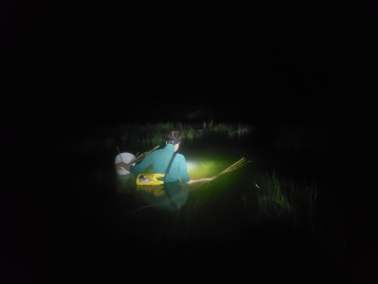These past few weeks we’ve stayed up way past our bedtimes, strapped on our headlamps, and headed out to the marsh for sampling during extremely high tides in the middle of the night. Why do we venture out during this dark, wet, dangerous time? We’re trying to catch one of the marsh’s most important marsh consumers (and one of my personal favorite fish).

The ecosystems of Plum Island marshes run through one type of tiny little fish, the mummichog. These little guys’ funny name comes from the Narragansett word for “going in crowds”, and chog crowds dominate the creeks that cut through the marsh. But that’s not enough for them; during these extreme high tides, they leave their marine homes, travel up and out of the creeks onto the flooded marsh platform, and feast on all of the insects, spiders, and other invertebrates that might have been surprised by the sudden influx of cold, salty water in their usually dry terrestrial habitat. Then they race back down, trying to get back into the creek before the receding tide leaves them (literally) high and dry. This is incredibly important for their growth, but also for the ability of the system as a whole to support big fish we all love to catch. These little guys gather all of that energy made on the land and bring it all back down to the marine ecosystem allowing these areas to support more of the bass, flounder, bluefish, and other fish we all love to catch. You can think of these little guys as a bridge, connecting these two separate areas of the marsh, linking them so that they function as one, unified system.
How do we study this link? We use a variety of traps and nets, strategically placed across the marsh, that will not only catch these mighty minnows (and any other animals making the same voyage), but will tell us how many of them are using a specified area of marsh. Flume nets and lift traps installed in permanent spots ranging from the edge of the creek to a set distance back from it need to be raised dring the flooding tide; hence the reason for our nocturnal expeditions. Doing this will help us answer questions like “how much of the marsh do fish use?”, “do they eat more bugs as they venture further away from their aquatic home?” “How does this link between the land and sea change with altered access to the marsh?” Hopefully, our soggy, muddy, nighttime exploits into the flooded marsh will give us some answers to these questions. The tide goes out, the sun comes up, and we venture out to the marsh again, to collect the fruits of our nocturnal adventure!
High tide tonight is at 1
We’re up all night to get some (mummichogs)
The marsh at night is good fun
We’re up all night to catch mummi(chogs)
– Justin Lesser (Ph.D. Student, University of Louisiana at Lafayette)
Gloria lesser
Now I understand